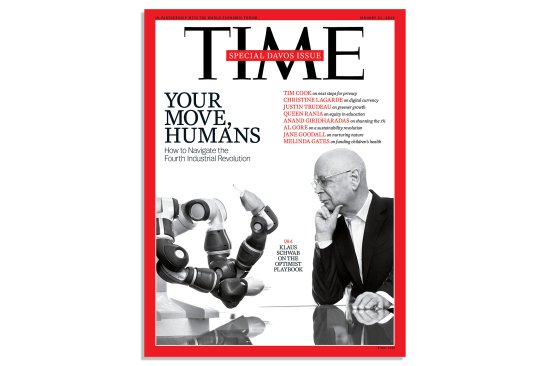
As a relative youngster among legacy publications like the Wall Street Journal (1889) and the New York Times (1851), 96-year-old TIME wasn’t around to cover the first or second industrial revolutions, in which steam and then electricity transformed the world’s economies. But we were early to the third, the one led by microchips and software, and stayed on it for half a century, perhaps most famously in a piece (written, ironically, on a 15-year-old Royal 440 typewriter) that named the computer “Machine of the Year” for 1982 and heralded the dawn of a new era.
About that era, we nailed some predictions (a “TV set hung like a picture,” solar heating, autonomous cars)—and called a few things wrong (like clothes “whisked spotless ultrasonically” and accurate weather predictions). But the sharpest eye of the period belonged to Boris Artzybasheff, the most prolific cover artist in TIME’s history, who as early as 1950 saw right through the third industrial revolution and into the fourth. His prescient, surrealist images of computers over the course of the ’50s and ’60s fused the technological and the human, connecting machines to people and machines to one another in ways that are only now becoming reality.
[time-brightcove not-tgx=”true”]

This special issue for Davos 2019 was produced in partnership with the World Economic Forum, whose insights and expertise helped us navigate through the wonder, fear, upheaval and opportunity that the fourth industrial revolution has sparked. Will unprecedented global connectivity, advances in automation and artificial intelligence lead to a future of unemployment, misinformation and class warfare—or, harnessed differently, to more empowerment, creativity and sustainability? Author Anand Giridharadas urges the denizens of Davos to stay out of the way and avoid “thwarting those who are working to bury this gilded age.” Others see space for opportunity and optimism. Venture capitalist and TIME 100 alumnus Kai-Fu Lee asks us to look past our fears of “robot overlords” and rest assured that the qualities of creativity, trust and empathy will keep humans gainfully employed. Former Vice President Al Gore predicts a “sustainability revolution” will help tackle the threat of the climate crisis.
The issue closes with eight profiles of inspiring rising leaders from around the world, the youngest of whom is Samaira Mehta, a 10-year-old entrepreneur who says this wave of technological change doesn’t have to be cause for alarm. “You can tell a computer to do something for you,” says Samaira, who has developed two board games that teach kids about coding. “And you can tell a computer to do something good for everyone else.”
Edward Felsenthal is the Editor-in-Chief of TIME.